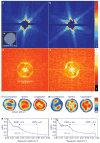Single mimivirus particles intercepted and imaged with an X-ray laser
- PMID: 21293374
- PMCID: PMC4038304
- DOI: 10.1038/nature09748
Single mimivirus particles intercepted and imaged with an X-ray laser
Abstract
X-ray lasers offer new capabilities in understanding the structure of biological systems, complex materials and matter under extreme conditions. Very short and extremely bright, coherent X-ray pulses can be used to outrun key damage processes and obtain a single diffraction pattern from a large macromolecule, a virus or a cell before the sample explodes and turns into plasma. The continuous diffraction pattern of non-crystalline objects permits oversampling and direct phase retrieval. Here we show that high-quality diffraction data can be obtained with a single X-ray pulse from a non-crystalline biological sample, a single mimivirus particle, which was injected into the pulsed beam of a hard-X-ray free-electron laser, the Linac Coherent Light Source. Calculations indicate that the energy deposited into the virus by the pulse heated the particle to over 100,000 K after the pulse had left the sample. The reconstructed exit wavefront (image) yielded 32-nm full-period resolution in a single exposure and showed no measurable damage. The reconstruction indicates inhomogeneous arrangement of dense material inside the virion. We expect that significantly higher resolutions will be achieved in such experiments with shorter and brighter photon pulses focused to a smaller area. The resolution in such experiments can be further extended for samples available in multiple identical copies.
Conflict of interest statement
The authors declare no competing financial interests.
Figures


Comment in
-
Diffraction before destruction.Nat Methods. 2011 Apr;8(4):283. doi: 10.1038/nmeth0411-283. Nat Methods. 2011. PMID: 21574275 No abstract available.
References
-
- Neutze R, et al. Potential for biomolecular imaging with femtosecond X-ray pulses. Nature. 2000;406:752–757. - PubMed
-
- Chapman HN, et al. Femtosecond diffractive imaging with a soft-X-ray free-electron laser. Nature Phys. 2006;2:839–843.
-
- Bergh M, et al. Feasibility of imaging living cells at sub-nanometer resolution by ultrafast X-ray diffraction. Q Rev Biophys. 2008;41:181–204. - PubMed
-
- Nagler B, et al. Turning solid aluminium transparent by intense soft X-ray photoionization. Nature Phys. 2009;5:693–696.
-
- Emma P, et al. First lasing and operation of an ångstrom-wavelength free-electron laser. Nature Photon. 2010;4:641–647.
Publication types
MeSH terms
Grants and funding
LinkOut - more resources
Full Text Sources
Other Literature Sources

